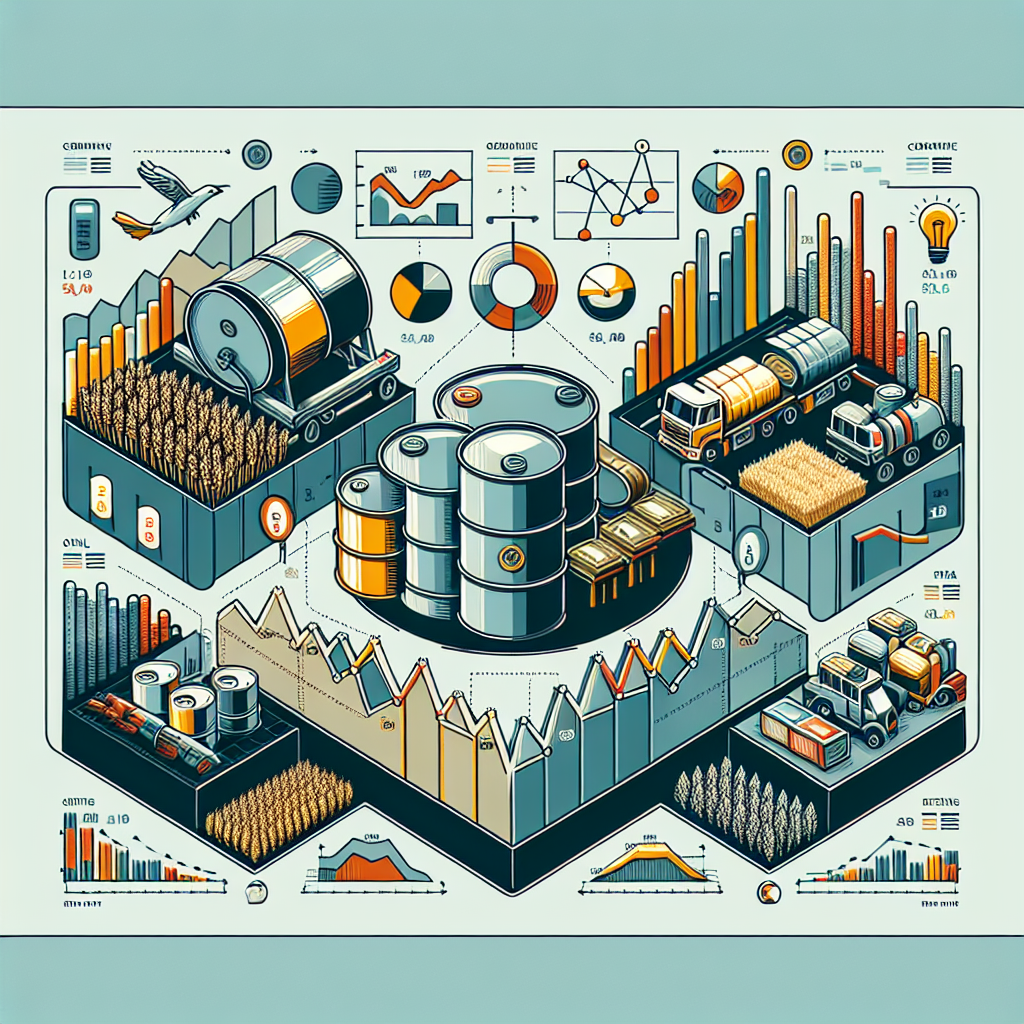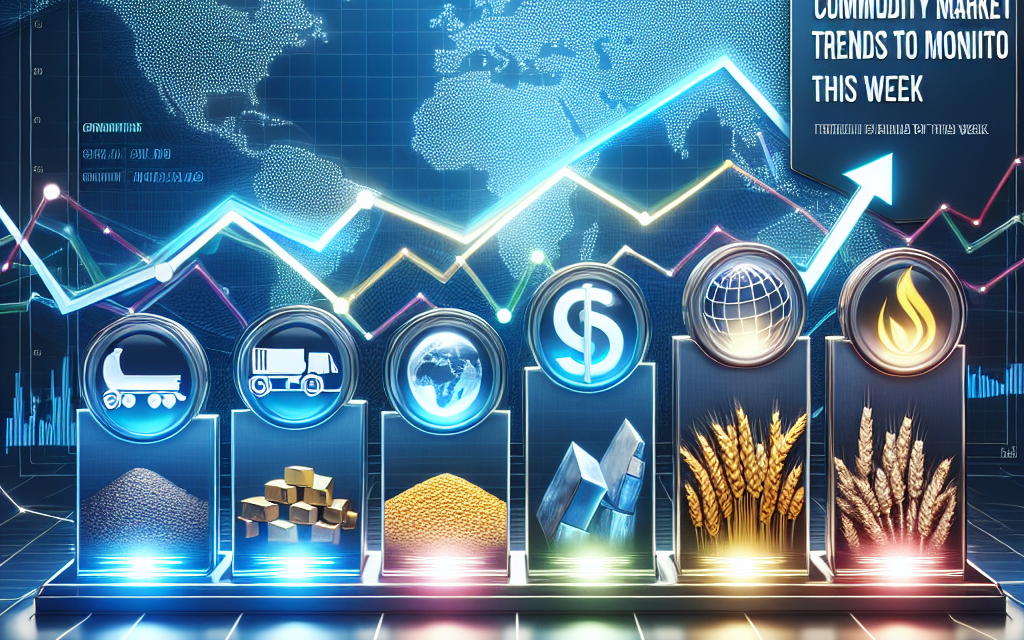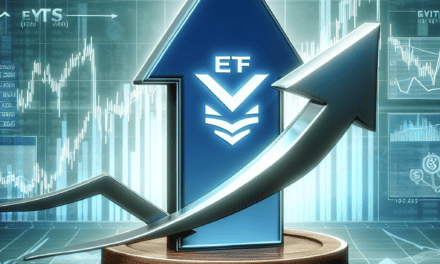“Navigate the Waves: Top 5 Global Commodity Market Trends to Watch This Week”
Introduction
As global markets continue to navigate a landscape marked by economic uncertainty and geopolitical tensions, the commodity sector remains a focal point for investors and analysts alike. This week, several key trends are poised to influence commodity prices and trading strategies. From fluctuations in energy markets driven by shifting supply dynamics to agricultural commodities reacting to climate conditions, these developments are crucial for stakeholders aiming to make informed decisions. Additionally, the impact of currency movements and regulatory changes on precious metals and industrial commodities cannot be overlooked. Here, we delve into the top five global commodity market trends that demand close attention in the coming days.
Impact Of Geopolitical Tensions On Commodity Prices
In the ever-evolving landscape of global commodity markets, geopolitical tensions play a pivotal role in shaping price dynamics. This week, as market participants keenly observe the unfolding geopolitical scenarios, it becomes imperative to understand how these tensions impact commodity prices. Geopolitical tensions, often unpredictable, can lead to significant volatility in commodity markets, affecting everything from crude oil to precious metals. As tensions escalate or de-escalate, they can trigger shifts in supply and demand, thereby influencing prices.
To begin with, crude oil remains one of the most sensitive commodities to geopolitical tensions. Given its critical role in the global economy, any disruption in oil-producing regions can lead to immediate price fluctuations. For instance, tensions in the Middle East, a region that holds a substantial portion of the world’s oil reserves, can lead to fears of supply disruptions. This, in turn, often results in a spike in oil prices as traders anticipate potential shortages. Conversely, any diplomatic resolutions or peace agreements can lead to a stabilization or even a decrease in prices as supply concerns are alleviated.
Similarly, natural gas markets are not immune to geopolitical influences. With Europe heavily reliant on natural gas imports, particularly from Russia, any geopolitical strife involving these regions can have profound implications. For example, conflicts or sanctions that threaten the flow of natural gas can lead to increased prices as countries scramble to secure alternative supplies. This week, market analysts are closely monitoring developments in Eastern Europe, as any escalation could lead to significant price movements in the natural gas sector.
In addition to energy commodities, agricultural products are also susceptible to geopolitical tensions. Countries embroiled in conflicts may face disruptions in their agricultural output, either due to direct impacts on farming activities or through trade restrictions imposed as part of broader sanctions. This can lead to reduced supply in global markets, driving up prices. For instance, tensions in the Black Sea region, a critical area for grain exports, can lead to concerns over wheat and corn supplies, thereby affecting global prices.
Moreover, precious metals such as gold and silver often serve as safe-haven assets during times of geopolitical uncertainty. Investors tend to flock to these commodities as a hedge against potential economic instability. Consequently, any increase in geopolitical tensions can lead to a rise in demand for precious metals, pushing their prices higher. This week, with several geopolitical hotspots under scrutiny, the demand for gold and silver is expected to remain robust as investors seek to mitigate risks.
Finally, industrial metals, including copper and aluminum, are also influenced by geopolitical developments. These metals are essential for various industries, and any disruptions in their supply chains can lead to price volatility. For instance, geopolitical tensions that affect major mining regions or transportation routes can lead to supply constraints, thereby driving up prices. As the global economy continues to recover, the demand for industrial metals remains strong, making them particularly sensitive to any geopolitical disruptions.
In conclusion, geopolitical tensions are a critical factor influencing global commodity prices. As market participants navigate the complexities of these tensions, understanding their potential impact on various commodities is essential. This week, as geopolitical developments unfold, keeping a close eye on these trends will be crucial for anyone involved in the commodity markets. By staying informed and anticipating potential shifts, stakeholders can better manage risks and capitalize on opportunities in this dynamic environment.
Fluctuations In Crude Oil Supply And Demand
In the ever-evolving landscape of global commodity markets, fluctuations in crude oil supply and demand remain a pivotal factor influencing economic stability and growth. This week, several key trends are emerging that warrant close attention from market analysts and investors alike. As the world continues to grapple with the aftermath of the pandemic and geopolitical tensions, understanding these trends is crucial for making informed decisions.
Firstly, the ongoing geopolitical tensions in the Middle East continue to cast a long shadow over crude oil supply. With major oil-producing nations embroiled in conflicts or facing internal strife, the risk of supply disruptions remains high. This uncertainty often leads to volatility in oil prices, as markets react to any potential threats to the steady flow of crude. Consequently, investors are advised to keep a close watch on developments in this region, as any escalation could lead to significant price swings.
In addition to geopolitical factors, the global economic recovery post-pandemic is another critical element affecting crude oil demand. As countries gradually reopen and economic activities resume, there is an anticipated increase in energy consumption. However, this recovery is uneven, with some regions rebounding faster than others. For instance, while the United States and parts of Europe are witnessing robust economic growth, other areas, particularly in Asia, are experiencing slower recoveries due to ongoing COVID-19 challenges. This disparity in recovery rates is likely to influence global oil demand patterns, making it essential for stakeholders to monitor economic indicators closely.
Moreover, the transition towards renewable energy sources is gradually reshaping the demand landscape for crude oil. As governments worldwide implement policies to reduce carbon emissions and promote sustainable energy, there is a growing shift away from fossil fuels. This transition, while necessary for environmental sustainability, poses challenges for the oil industry. Companies are now compelled to adapt to this changing environment by investing in cleaner technologies and diversifying their energy portfolios. Consequently, the pace of this transition and its impact on oil demand is a trend that cannot be overlooked.
Furthermore, the role of OPEC+ in managing oil supply remains a significant factor in the market. The alliance’s decisions on production quotas can have profound effects on global oil prices. Recently, OPEC+ has been navigating the delicate balance between supporting prices and ensuring adequate supply to meet recovering demand. Any changes in their production strategy, whether to increase or decrease output, will likely have immediate repercussions on the market. Therefore, keeping abreast of OPEC+ meetings and announcements is crucial for anticipating market movements.
Lastly, technological advancements in oil extraction and production are influencing supply dynamics. Innovations such as enhanced oil recovery techniques and digitalization in oil fields are improving efficiency and reducing costs. These advancements enable producers to maintain or even increase output despite challenging market conditions. As technology continues to evolve, its impact on supply capabilities and cost structures will be a trend worth monitoring.
In conclusion, the interplay of geopolitical tensions, economic recovery, renewable energy transition, OPEC+ strategies, and technological advancements creates a complex web of factors affecting crude oil supply and demand. By staying informed about these trends, market participants can better navigate the uncertainties and capitalize on opportunities within the global commodity markets. As the week unfolds, these elements will undoubtedly shape the trajectory of crude oil prices and, by extension, the broader economic landscape.
Agricultural Commodity Price Volatility
In the ever-evolving landscape of global commodity markets, agricultural commodities often stand out due to their inherent volatility. This week, several key trends are shaping the dynamics of agricultural commodity prices, warranting close attention from market participants. Understanding these trends is crucial for stakeholders ranging from farmers to investors, as they navigate the complexities of supply and demand, geopolitical influences, and environmental factors.
To begin with, weather patterns continue to play a pivotal role in agricultural commodity price volatility. Unpredictable weather conditions, such as droughts, floods, and unseasonal frosts, can significantly impact crop yields. For instance, recent reports of adverse weather in major grain-producing regions have raised concerns about potential supply shortages. Consequently, this has led to increased price volatility as markets react to the possibility of reduced harvests. As climate change continues to influence weather patterns globally, monitoring meteorological forecasts becomes increasingly important for anticipating price movements in agricultural commodities.
In addition to weather-related factors, geopolitical tensions are another critical element contributing to price fluctuations. Trade policies, tariffs, and international relations can all affect the flow of agricultural goods across borders. For example, ongoing trade negotiations between major economies can lead to uncertainty in the market, as stakeholders speculate on potential changes in trade agreements. This uncertainty often results in price volatility, as traders adjust their positions based on anticipated policy shifts. Therefore, keeping abreast of geopolitical developments is essential for understanding the broader context of agricultural commodity markets.
Moreover, technological advancements are reshaping the agricultural sector, influencing both production and pricing. Innovations in farming techniques, such as precision agriculture and genetically modified crops, have the potential to enhance productivity and efficiency. However, the adoption of these technologies can also introduce new variables into the market. For instance, while increased yields may lead to lower prices due to higher supply, the initial costs of implementing advanced technologies could offset these gains. As such, stakeholders must consider the implications of technological progress on both short-term price volatility and long-term market trends.
Furthermore, the growing emphasis on sustainability and environmental responsibility is impacting agricultural commodity markets. Consumers and governments alike are increasingly prioritizing sustainable practices, which can affect production methods and supply chains. For example, the demand for organic and sustainably sourced products is rising, potentially leading to price premiums for these commodities. Additionally, regulatory changes aimed at reducing carbon footprints and promoting sustainable agriculture can influence market dynamics. As a result, understanding the intersection of sustainability and commodity pricing is becoming increasingly important for market participants.
Lastly, currency fluctuations are a significant factor in agricultural commodity price volatility. Since commodities are typically traded in U.S. dollars, changes in currency exchange rates can affect the purchasing power of importing countries. A stronger dollar, for instance, can make commodities more expensive for foreign buyers, potentially dampening demand and leading to price adjustments. Conversely, a weaker dollar may boost demand by making commodities more affordable internationally. Therefore, monitoring currency trends is essential for anticipating potential impacts on agricultural commodity prices.
In conclusion, the agricultural commodity market is influenced by a myriad of factors, each contributing to price volatility in unique ways. By closely monitoring weather patterns, geopolitical developments, technological advancements, sustainability trends, and currency fluctuations, stakeholders can better navigate the complexities of this dynamic market. As these trends continue to evolve, staying informed and adaptable will be key to successfully managing the challenges and opportunities that arise in the global agricultural commodity landscape.
Precious Metals As Safe Haven Investments

In the ever-evolving landscape of global commodity markets, precious metals continue to hold a significant position as safe haven investments. This week, several trends are emerging that investors should closely monitor. As economic uncertainties persist, the allure of precious metals like gold and silver remains strong, driven by their historical role as reliable stores of value. Consequently, understanding these trends is crucial for investors seeking to navigate the complexities of the current market environment.
Firstly, the ongoing geopolitical tensions are playing a pivotal role in shaping the demand for precious metals. With conflicts and diplomatic standoffs making headlines, investors are increasingly turning to gold and silver as a hedge against potential market volatility. This trend is further amplified by the fluctuating dynamics of international relations, which often lead to unpredictable shifts in market sentiment. As a result, the demand for precious metals is likely to remain robust, providing a buffer against geopolitical uncertainties.
In addition to geopolitical factors, inflationary pressures are another critical element influencing the precious metals market. As central banks around the world grapple with rising inflation rates, the appeal of gold and silver as inflation hedges becomes more pronounced. Historically, these metals have been perceived as effective tools for preserving purchasing power during periods of inflation. Consequently, investors are keenly observing inflation data and central bank policies, as these will significantly impact the trajectory of precious metal prices in the coming weeks.
Moreover, the fluctuating strength of the US dollar is a key determinant of precious metal prices. Typically, there is an inverse relationship between the value of the dollar and the price of gold and silver. When the dollar weakens, precious metals become more attractive to investors holding other currencies, thereby driving up demand. This week, market participants are closely watching currency movements, as any significant shifts in the dollar’s value could have a profound impact on the precious metals market.
Furthermore, technological advancements and their implications for industrial demand are also shaping the precious metals landscape. Silver, in particular, is witnessing increased demand due to its applications in emerging technologies such as solar panels and electric vehicles. As the world transitions towards cleaner energy solutions, the industrial demand for silver is expected to rise, potentially influencing its market dynamics. Investors are therefore advised to keep an eye on technological developments and their potential impact on silver demand.
Lastly, the role of central banks in the precious metals market cannot be overlooked. Central banks are significant players, often holding substantial reserves of gold. Their buying and selling activities can influence market prices and investor sentiment. This week, any announcements or policy changes from major central banks regarding their gold reserves could lead to notable market movements. Investors should remain vigilant, as central bank actions can provide valuable insights into future market trends.
In conclusion, the precious metals market is currently influenced by a confluence of factors, including geopolitical tensions, inflationary pressures, currency fluctuations, technological advancements, and central bank activities. As these trends continue to unfold, investors must stay informed and adapt their strategies accordingly. By closely monitoring these developments, investors can better position themselves to capitalize on the opportunities presented by the dynamic and ever-changing precious metals market.
Currency Exchange Rates Affecting Commodity Markets
In the ever-evolving landscape of global commodity markets, currency exchange rates play a pivotal role in shaping market dynamics. This week, several key trends in currency fluctuations are poised to impact commodity prices, influencing both producers and consumers worldwide. Understanding these trends is crucial for stakeholders aiming to navigate the complexities of the market effectively.
To begin with, the strength of the U.S. dollar remains a significant factor affecting commodity prices. As the world’s primary reserve currency, the dollar’s value directly influences the cost of commodities priced in dollars, such as oil, gold, and agricultural products. A stronger dollar typically makes these commodities more expensive for foreign buyers, potentially dampening demand. This week, market participants are closely monitoring the Federal Reserve’s monetary policy signals, as any indication of interest rate adjustments could further bolster the dollar, thereby exerting downward pressure on commodity prices.
In contrast, the euro’s performance against the dollar is another critical element to watch. The eurozone’s economic health, influenced by factors such as inflation rates and economic growth forecasts, can sway the euro’s value. A weaker euro could make European exports more competitive, potentially increasing demand for commodities like crude oil and natural gas. However, it could also lead to higher import costs for raw materials, affecting European manufacturers. This week, economic data releases from major eurozone economies are expected to provide insights into the euro’s trajectory, with implications for commodity markets.
Moreover, the Chinese yuan’s exchange rate is a focal point for commodity traders, given China’s status as a major consumer of raw materials. The yuan’s value is influenced by China’s economic policies and trade relations, particularly with the United States. A depreciating yuan could reduce China’s purchasing power for commodities, potentially leading to lower demand and price adjustments. This week, developments in U.S.-China trade negotiations and China’s economic indicators will be closely scrutinized, as they could impact the yuan’s stability and, consequently, global commodity demand.
Additionally, emerging market currencies are under the spotlight, as their volatility can significantly affect commodity markets. Countries like Brazil, Russia, and South Africa are major producers of commodities such as oil, metals, and agricultural products. Fluctuations in their currencies can alter production costs and export competitiveness. For instance, a weaker Brazilian real could make Brazilian soybeans more attractive to international buyers, potentially affecting global supply and demand dynamics. This week, geopolitical events and domestic economic policies in these countries are likely to influence their currency movements, with ripple effects on commodity markets.
Finally, the Japanese yen’s role as a safe-haven currency cannot be overlooked. In times of global economic uncertainty, investors often flock to the yen, driving up its value. This appreciation can impact Japan’s import-dependent economy, affecting its demand for commodities like oil and natural gas. This week, global economic indicators and geopolitical tensions will be key factors determining the yen’s strength, with potential implications for commodity markets.
In conclusion, currency exchange rates are a crucial determinant of commodity market trends. This week, the interplay between major currencies such as the U.S. dollar, euro, Chinese yuan, and others will be instrumental in shaping commodity prices. By closely monitoring these currency movements, market participants can better anticipate shifts in supply and demand, enabling them to make informed decisions in an increasingly interconnected global economy.
Technological Advancements In Commodity Trading
In recent years, technological advancements have significantly reshaped the landscape of commodity trading, introducing new efficiencies and opportunities for market participants. This week, several key trends are emerging that highlight the profound impact of technology on global commodity markets. As traders and investors navigate these changes, understanding the role of technology becomes increasingly crucial.
Firstly, the integration of artificial intelligence (AI) and machine learning in commodity trading platforms is revolutionizing how data is analyzed and decisions are made. These technologies enable traders to process vast amounts of data at unprecedented speeds, identifying patterns and trends that would be impossible to discern manually. For instance, AI algorithms can analyze historical price data, weather patterns, and geopolitical events to forecast commodity prices with remarkable accuracy. This not only enhances decision-making but also reduces the risk of human error, providing traders with a competitive edge in a fast-paced market environment.
Moreover, blockchain technology is gaining traction as a tool for enhancing transparency and security in commodity trading. By providing a decentralized and immutable ledger, blockchain ensures that all transactions are recorded accurately and can be verified by all parties involved. This is particularly beneficial in commodities such as gold and oil, where the provenance and authenticity of the product are critical. Blockchain can streamline the supply chain, reduce fraud, and increase trust among market participants, ultimately leading to more efficient and reliable trading processes.
In addition to AI and blockchain, the rise of digital platforms and online marketplaces is democratizing access to commodity trading. These platforms allow individual investors and smaller firms to participate in markets that were once dominated by large financial institutions. By lowering barriers to entry, digital platforms are fostering greater competition and innovation within the industry. Furthermore, they offer advanced tools and resources that were previously unavailable to smaller players, leveling the playing field and enabling a more diverse range of participants to engage in commodity trading.
Another significant trend is the increasing use of big data analytics to inform trading strategies. With the proliferation of data from various sources, including social media, satellite imagery, and IoT devices, traders have access to a wealth of information that can influence market dynamics. Big data analytics allows traders to synthesize this information and gain insights into factors that may impact commodity prices, such as changes in consumer behavior, supply chain disruptions, or shifts in regulatory policies. By leveraging big data, traders can make more informed decisions and respond more swiftly to market changes.
Finally, the adoption of automated trading systems is transforming the speed and efficiency of executing trades. These systems use algorithms to automatically execute trades based on predefined criteria, eliminating the need for manual intervention. This not only reduces transaction costs but also minimizes the time lag between decision-making and trade execution. As a result, traders can capitalize on market opportunities more quickly and effectively, enhancing their overall performance.
In conclusion, technological advancements are playing a pivotal role in shaping the future of commodity trading. From AI and blockchain to digital platforms and big data analytics, these innovations are driving greater efficiency, transparency, and accessibility in the market. As these trends continue to evolve, staying informed about technological developments will be essential for traders and investors seeking to navigate the complexities of the global commodity markets.
Environmental Policies Influencing Commodity Production
In recent years, the intersection of environmental policies and commodity production has become increasingly significant, shaping market dynamics in profound ways. As global awareness of climate change and sustainability intensifies, governments and organizations are implementing policies that directly impact the production and distribution of commodities. This week, several key trends in this domain warrant close attention, as they have the potential to influence market behavior and investment strategies.
Firstly, the push for renewable energy sources continues to reshape the landscape of commodity production. Governments worldwide are enacting policies to reduce carbon emissions, which in turn affects the demand for fossil fuels. For instance, the European Union’s Green Deal aims to make Europe the first climate-neutral continent by 2050, significantly impacting coal and oil markets. As countries transition to cleaner energy, the demand for commodities like lithium, cobalt, and nickel, essential for battery production, is expected to rise. This shift not only alters the demand dynamics but also encourages investment in mining and processing facilities for these critical minerals.
Moreover, deforestation policies are increasingly influencing agricultural commodities. Nations such as Brazil, which is home to vast portions of the Amazon rainforest, are under international pressure to curb deforestation. This has direct implications for commodities like soybeans and beef, which are major drivers of land clearing. As stricter regulations are enforced, production costs may rise, potentially leading to higher prices in global markets. Consequently, investors and producers must navigate these regulatory landscapes carefully, balancing environmental responsibilities with economic interests.
In addition to energy and agriculture, water usage policies are becoming a focal point in commodity production. Water scarcity is a growing concern, particularly in regions heavily reliant on agriculture and mining. Countries are implementing measures to manage water resources more sustainably, affecting the production of water-intensive commodities such as cotton and rice. For example, India and China, two of the largest producers of these crops, are adopting policies to optimize water usage, which could influence global supply and pricing structures. As these policies take effect, they may drive innovation in water-efficient technologies and practices, further transforming the commodity market.
Furthermore, the circular economy concept is gaining traction, promoting the recycling and reuse of materials to minimize waste. This approach is influencing the production and consumption of commodities like plastics and metals. Governments are introducing regulations to encourage recycling and reduce reliance on virgin materials, impacting industries ranging from packaging to electronics. As a result, companies are investing in sustainable practices and technologies to align with these policies, potentially altering supply chains and cost structures.
Lastly, biodiversity conservation efforts are increasingly affecting commodity markets. The protection of ecosystems and endangered species is prompting changes in land use and resource extraction practices. For instance, palm oil production, often linked to habitat destruction, is facing stricter regulations and certification requirements. These measures aim to ensure sustainable production practices, which can affect supply and demand dynamics. As consumers and investors become more environmentally conscious, companies are compelled to adopt sustainable practices, influencing market trends and competitive positioning.
In conclusion, environmental policies are playing a pivotal role in shaping the production and distribution of commodities globally. As these policies evolve, they present both challenges and opportunities for market participants. By closely monitoring these trends, stakeholders can better anticipate changes in market dynamics and make informed decisions that align with both economic and environmental objectives.
Q&A
1. **Oil Price Fluctuations**: This week, monitor the impact of geopolitical tensions and OPEC+ production decisions on oil prices, as these factors could lead to significant volatility in the market.
2. **Natural Gas Supply Concerns**: Keep an eye on natural gas markets, particularly in Europe, where supply disruptions or changes in demand due to weather conditions could influence prices.
3. **Agricultural Commodity Prices**: Watch for changes in agricultural commodity prices, such as wheat and corn, driven by weather patterns, export demand, and global supply chain issues.
4. **Metals Market Movements**: Pay attention to the metals market, especially copper and aluminum, as economic data from major economies like China and the U.S. could affect demand and pricing.
5. **Currency Fluctuations Impacting Commodities**: Observe how currency fluctuations, particularly the strength of the U.S. dollar, are impacting commodity prices, as a stronger dollar can make commodities more expensive for foreign buyers.
Conclusion
This week, the top five global commodity market trends to monitor include:
1. **Energy Prices Volatility**: Fluctuations in oil and natural gas prices continue due to geopolitical tensions and supply chain disruptions, impacting global energy markets and influencing inflationary pressures.
2. **Agricultural Commodities**: Weather patterns and trade policies are affecting the supply and pricing of key agricultural commodities like wheat, corn, and soybeans, with potential implications for food security and pricing.
3. **Precious Metals Demand**: Gold and silver markets are experiencing shifts as investors react to economic data and central bank policies, with potential impacts on safe-haven demand and investment strategies.
4. **Base Metals Supply Constraints**: Ongoing supply chain issues and production challenges in key producing regions are affecting the availability and pricing of base metals such as copper and aluminum, crucial for industrial applications.
5. **Currency Fluctuations**: Exchange rate movements are influencing commodity prices, particularly in emerging markets, where currency depreciation can exacerbate inflation and affect import costs.
In conclusion, these trends highlight the interconnectedness of global markets and the importance of monitoring geopolitical developments, weather conditions, and economic policies, as they collectively shape the dynamics of the commodity markets.





